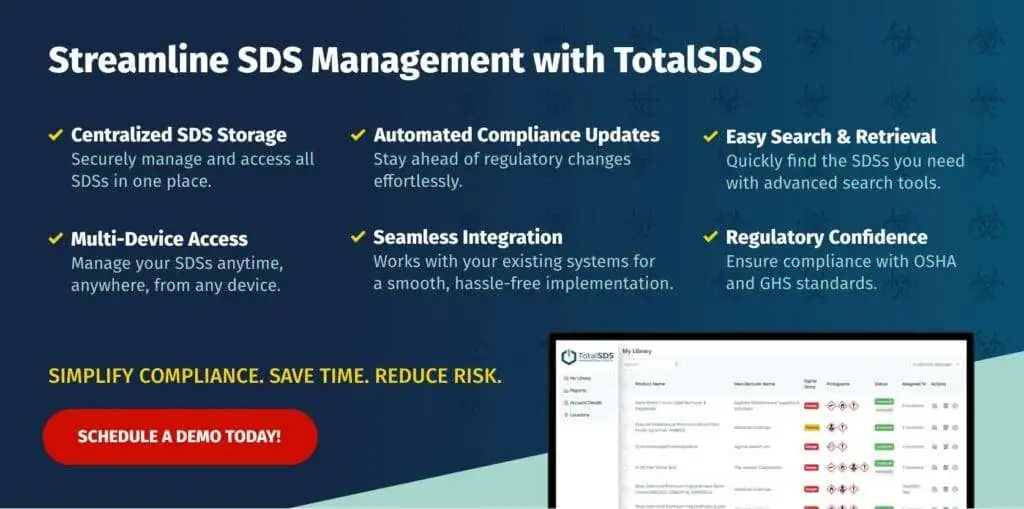When you run a business, there is never a shortage of things to do. Often, it may seem impossible to stay current on all the ever-changing GHS regulations governing the chemicals in your workplace – but it can be done. Deploying efficiencies across the business also means having a clear understanding of safety data sheets, ensuring compliance and informed decision making when it comes to safety for employees and across the business.
TotalSDS can help you ensure that your safety data sheets (SDSs) are readily available, up-to-date and easily accessible from computers, tablets and mobile devices. Not only this, but utilizing SDS Authoring software can help streamline the creation of SDSs and eliminate the cumbersome process of ensuring compliance on all fronts.
We’re providing a basic SDS guide to help provide an outline of the needs and requirements for creating these essential documents.
Are Safety Data Sheets Mandatory?
Simplifying the process: what does an SDS tell you? SDSs provide information on the properties of chemicals and how they can affect health and safety in the workplace. They also include instruction for safe handling, storage, and disposal of the chemical product.
Products can be categorized as hazardous and it’s essential that you identify and answer pertinent questions such as:
- What is the product?
- What are the hazards?
- What are the safety protocols for the product?
- What is the protocol incase of an emergency?
Every jurisdiction has different laws around regulatory compliance. The US, for example, operates under OSHA Hazard Communication Standard (HCS). Depending on the product and your jurisdiction, SDSs are likely mandatory for manufacturing, supplying, distributing or importing certain hazards. Learn more about OSHA training and compliance here.
Step 1. Learn & Assign
- Familiarize yourself with OSHA’s Hazard Communication Standard and its provisions so you can better determine what is needed for compliance in your workplace.
- Assign someone primary responsibility for coordinating the implementation of an effective hazard communication program that addresses all of the necessary components, including training.
Step 2. Prepare & Implement
- Prepare a written plan to indicate how hazard communication for labels and other forms of warning, safety data sheets, and employee information and training will be addressed in your workplace.
- Prepare an inventory list of all hazardous chemicals in the workplace using the chemical identifier (CAS#) to prepare the list so that you can track the status of SDSs and labels for a particular hazardous chemical.
Step 3. Label
- Keep labels on shipping containers with the following information: chemical identifier, signal word, pictograms, hazard statements, precautionary statements, and the name, address and phone number of the responsible party.
- Label workplace containers where required as any container of hazardous chemicals in the workplace must – at a minimum – include the chemical identifier and general information concerning the hazards of the chemical.
Step 4. Maintain
Where should SDSs be kept? In general, selecting from a central location that is easily accessible to all employees who may be exposed to hazardous chemicals is key. The storage should be well-organized, to make SDSs easy to locate and retrieve. In this way, storing safety data sheets electronically can help resolve issues with maintenance and accessibility. Consider the following:
- Maintain safety data sheets for each hazardous chemical in the workplace with detailed information on each particular hazardous chemical.
- Ensure that safety data sheets are readily accessible to employees when they are in their work areas during their work shifts. Software is available to help you easily author SDSs based on required standards, manage and maintain your collection of SDSs as well as access your safely cloud-based safety data sheets at any time.
Step 5. Inform & Train
- Train employees on the current hazardous chemicals in their work area, new hazards as they are introduced, and how to access the safety data sheets.
- Also inform employees of the requirements of the standard, chemicals hazards, the appropriate protective measures, how to implement these measures, and who to contact if an issue arises.
Step 6. Review & Reassess
- Review your hazard communication program periodically to make sure that it remains current and relevant for you and your employees.
- Revise your program as appropriate to address changed conditions in the workplace such as the introduction of new chemicals or new hazards.
Regulatory Compliance for SDS
Staying on top of regulatory compliance for SDS can be complex, especially as requirements evolve across industries and jurisdictions. TotalSDS simplifies this process by providing a comprehensive SDS management solution designed to help you meet OSHA, WHMIS, GHS, and other global standards with confidence. Our platform ensures your safety data sheets are always accurate, accessible, and up to date — empowering your team to maintain full compliance without the administrative burden.




